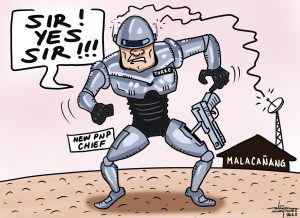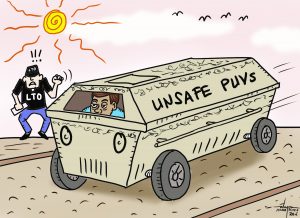Jalian. Somehow, when pronounced the word sounds closely similar to a product brand that has been laced with controversy and corruption in government.
Yes, isn’t Jalian sounding like the controversial Dalian, the train brand purchased during the Aquino administration to service the passenger requirements of the Metro Rail Transport (MRT) 3? Isn’t Dalian the train cars that until now only one unit has been on test run and the rest still evaluated by the new maintenance company of the railway because these are not compatible with the existing rail facilities?
And what is this Jalian thing that we are bringing up here in our column? It is the elevator brand being installed as component of several overpasses being built in some parts of Davao City like Calinan and Mintal in the third district. Each overpass project has two Jalian elevators installed, one on each side.
Last Sunday we had the opportunity to closely examine the lifting equipment right on the base at the ground and on top of the overpass. We noticed that the boxes that house the electrical control in operating the elevators are already destroyed like these had been there for years and have aged because of too much use.
But no, it’s not because of the number of years that the lifts are being used because we know, as well as many others are well aware of, that the elevators have not been used since the completion of the overpass. The Calinan overpass is barely five years old; so are the elevators.
Looking at the project now any one does not need a magnifying glass to see its deterioration level along with the Jalian elevators that are manufactured by Zeilian Jalian Elevators, Inc. And like the Dalian trains the lifts are from – where else, but China.
Again, we are calling on the Commission on Audit (COA) to look into the quality of the construction of the overpass itself, in the same way that we had called the agency’s attention to pry into the secrets of the non-use of the Jalian lifts.
We really cannot help but wonder why the COA has not red-flagged the agency implementing the overpass projects. It has the technical people who are hired to look into the quality of the workmanship as well as the construction materials used on the project. But how come these supposedly technical men of the COA failed to see the obvious lack in the quality of workmanship and some of the materials used in the project?
One example is the less than 5 mm thick plain galvanized iron sheet used as stopper in between steps of the stairs. If the COA people will just find time to visit any of the overpass projects we have always been harping about in this column we can be certain they will not miss seeing the GI sheet stoppers already detached from the concrete steps of the stairs.
These detaching stoppers can very well pose as risk to both overpass users and those pedestrian passing under the stairs. Those users climbing up could possibly slide any of their feet into the unprotected steps when these are wet and slippery. And such incident could lead into broken limbs.
On the other hand, if the less than 5 mm thick GI sheet stoppers now precariously hanging will eventually fall these could hit any unlucky pedestrian. That definitely could result to injury or even death.
Unfortunately, despite our having harpooned the government agencies that have participation in the implementation and acceptance of the overpass projects like the Department of Public Works and Highways (DPWH), the local government of Davao City through its City Engineer’s Office (CEO), the Congressional Offices, and of course the COA on the specific issue of non-operating elevators, no one bothered to answer or give even a whimper of an explanation.
Hence, we have no other option but to think that the “culturized” blue bills giving during debuts of young ladies may have something to do with the agencies’ conspiring “silence of the lamb” attitude.
Yes, it is very likely that some blue bills – plenty of them – may have guided the agencies technical men’s hands into signing project acceptance recommendation, or covered their eyes to prevent them from seeing the unacceptable workmanship and the low quality materials being used in the project construction.
If we have to repeat our contention before that should the basis in the computation of a fair return on investment (ROI) on the overpass projects concerned is the number of its users, then we can be dead certain that the overpasses concerned are far from getting the desired figure.
Meanwhile, the line in a Lobo song that says, “Rust never sleeps” aptly suits the condition of the overpasses specifically its elevator component.
Very soon people will find that rust already put the project in jeopardy. Those elevators will most likely be headed to the junk shops and sold on a per kilo basis.
What a way to rob government of people’s money, sadly, by the very people whom it has entrusted to implement such projects.
– 30 –


